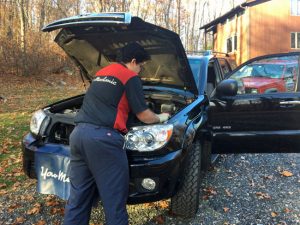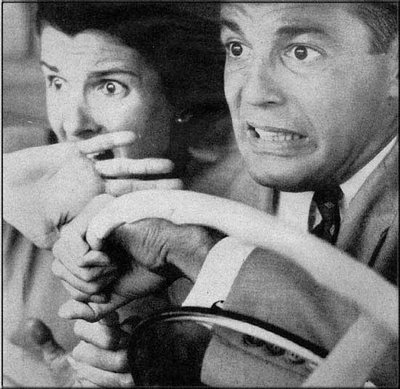4 Easy Steps to Repair Your Car Without the Stress Pt. II

We know how tricky it is to keep your car in good shape with all of the confusing advice out there.
In our last post, “4 Easy Steps to Repair Your Car Without the Stress Pt. 1”, we discussed four tips to help you simplify your car’s maintenance and repair work.
As promised, we’ll discuss four more tips that will help you turn car care into an easier process.
1. Fix problems at the right time
Don’t let a pebble turn into a boulder and don’t make a boulder out of a pebble. In other words, don’t panic over small problems and don’t take the big ones lightly. With that said, there’s one key element that you’ve got to get right…
You’ve got to know when to worry about something. The truth is that some repairs – although it’s always better to fix something sooner than later – can wait a bit. Doing so can save you money. But others will quickly swell up in costs, damage other car parts or put you at risk for an accident, making it vital for you to fix them right away. But it’s one thing to agree with this yet another to know what takes priority. How do you figure this all out?

Know when to fix what
To gain a sense of when and when not to fix something, you’ll need to know how long your car parts will “live”. You can do this without having to spend a dime or hours of your time on auto mechanic courses.
Most car parts have been noted to last for a certain amount of time, whether it’s for a few months or years. This can vary from car to car since brands receive their supply of parts from different manufacturers. But generally speaking, the most vital car components last for a similar length of time.
Some of this relates to your car’s scheduling, which we discussed as our first point in our previous post. Of course, others may occur in response to an accident or an encounter with a roadside obstacle.

| Can Wait | Can’t Wait |
| Minor oil leaks | Oil changes |
| Some belts and hoses | Coolant leaks |
| Dents and scratches | Strange noises |
| Torn seats/upholstery | Tire damage |
| Paint jobs | Brake problems |
| Minor glass chips | Steering problems |
| Air filters | Noisy ball joints |
Some will agree or disagree with the parts and changes mentioned above, but here’s the rule of thumb: cosmetic and non-essential parts (not engine-related) don’t need immediate fixes, whereas engine and drivetrain and emission components can’t wait.
So make sure to keep a mental reference of what needs an immediate fix and what can stay on the backburner. By doing that, you won’t overspend nor stress nor fix something that ain’t broke in the first place.
2. Inspect from Time to Time (with a look and a listen and a sniff)
Your mechanic isn’t the only one who should be snooping around your vehicle. You owe it to yourself to do your own inspections as well. And no, saying “I’m not a mechanic” is no excuse.
Don’t leave all the work to your mechanic
There are several signals your car gives off at any given moment by means of a dashboard symbol or by some “behaviour”. And your mechanic shouldn’t be the one to point it out. If you’re paying attention to your car’s performance, which you should be doing, you’ll more than likely know if something is off.
You’ll stay a click ahead
Here’s why this is important. Imagine your car starts leaking fluids of sorts, and you’re not scheduled for an oil change for at least another two or three months. There could be other signs too, like strange sounds from the engine. Maybe you overlook the stains on your driveway and the rattling under the hood.
Two months later, you drive to the mechanic’s, and he says “you’ve got a major leak”. He tells you the repair bill – you cringe. Maybe the repair job was inevitable, but had you noticed it earlier, the damage and the costs could have been far less. And that’s why the occasional DIY inspection is vital.
But where do you start and on what do you focus? The outside? Inside? Under the hood? Ideally, you should look at it all.
Exterior

- Body – Look at the bigger picture but also zoom in on the details. Rust patches, deep dents and hidden scratches can creep up on you, so look out for them especially if you plan to sell your car.
- Doors – Open and close. Repeat. Are there creaks or is it hard to open? Any unusual activity could mean your door needs lubrication or some other fix.
- Tires – Look at your tire’s surface closely. Check for “bald spots”, cracks or unevenly worn treads to see if it’s time to have your tires fixed or replaced completely.
- Lights – Always inspect your lights. Flash your headlamps and check to see that both your front and rear bulbs shine. Also, while parked, hit the brakes and have a family member or spouse check to see that the brake light shines.
- Windows (windshield and mirrors too) – Look for chips, cracks and displacements (i.e. loose side mirror). Small scratches aren’t necessarily a big deal, but keep an eye out for a crack the spreads further as this will likely lead to a needed window replacement.
- Suspension – Circle your car to see if it’s level or it leans slightly to one side. Gently bounce each side. If it bounces on its own after you’ve done it, then your suspension may need realignment.
Interior

- Seats – Look to see if your seat is stuck in a certain position to ensure that you’re driving comfortably. If it’s stuck, you can bring this up to a mechanic or a dealer. Rips and stains aren’t the end of the world of course, but keep an eye open so you can remove or repair them before they get worse or become permanent.
- Dashboard – Take a mental snapshot of your dashboard now, so that you’ll know if a symbol stops shining. This is a big deal. If a light suddenly goes dark, you may not know when a car part needs fixing until it’s too late.
- Lights – When driving at night, is the interior well-lit or does it seem a bit dimmer than usual? Keep an eye out for dull bulbs and replace them.
- Sounds – A rattle here, a squeal there…don’t dismiss these sounds as just being in your head. Unless it’s engine starting up or roaring, any other sound you hear is something to make note of and address early on.
- Smells – A burning smell could signal an oil leak. A rotten egg smell could signal a catalytic converter issue. The lesson here is that any smell, unless it’s that of a car freshener or brand new leather, is something to keep in mind and address right away.
- Under the hood – Things get tricky here. Mechanically-inclined or not, you can pop the hood open to check a few things such as vapour rising from the engine (sign of overheating). If you’ve got some mechanical chops, you can inspect your fluids to ensure they’re the right colours, using a guide like this.
3. Buy Used Car Parts Cautiously
We’ve all had those times where our cars needed an emergency or really expensive fix. Whatever the case, money was an issue. So to solve the problem, we might have thought of getting a cheaper fix, which for many, means getting a used part.
Not all parts are made equal
Some car parts should never be used twice, however. While you can solve some issues with a used part, going this route with others can be disastrous for your car and make you spend even more than if you had bought a new part in the first place.
Some car parts will need to be replaced with new ones only. The reason for this is that their purpose is critical, and to rely on a used part which could already be damaged or worn-out, can mean trouble for you while driving. For example, you might end up having to replace that part again, or it could die on you and lead to a roadside breakdown.
And then again, there are some car parts that you can take the cheapskate route with. After all, why pay a premium price for a part that’s cosmetic in nature, or has no real impact your car’s performance? That brings us to distinguishing which parts you can buy used and which ones you should buy new.

Better to Buy New
- Alternators
- Air bags
- Batteries
- Brakes (rotors, discs, pads)
- Motor mounts
- Safety belts
- Seals
- Shocks
- Struts
- Sensors
Okay to Buy Used
- Light units (tail lights, head lights)
- Rims
- Power locks
- Windows
- Mirrors
- Transmission
- Interior components (i.e. steering wheel, car seat)
Of course, you can make some exceptions for this list. For example, used tires are acceptable if the treads are intact and there are no cracks and if you don’t plan on using the tires (or the car) much longer.
If you’re still unsure whether you should buy a part new or used, you can always consult your mechanic or dealership to get advice on what decision to make.
4. Follow Your Manual!
Now here’s the greatest, grandest yet quickest piece of advice to takeaway, and the one to listen to if you decide to ignore everything else: read your manual! Trust us here. There are some questions the mechanic can’t answer, the internet can’t answer and sometimes the dealership can’t answer. In many of those cases the manual will clear your confusion.
We know – you don’t want to sit there and read a 100+ page booklet. After all, a Google search is quicker too. But there are few sites that can offer you a trustworthy answer as to what’s going wrong with your car the way your manual does.
It will explain the meaning behind those confusing dashboard symbols. It will give you a schedule of when to repair or replace certain car parts. You will also learn all the little details about your car that you wouldn’t know unless you were in the factory when it was built.

So we’ll stress this point again – if you decide to listen or to remember just one piece of advice, it should be this: read your manual! Following its instructions will help you stay on top of repairs, which will save you money and hassles down the road.
Don’t Sweat Car Maintenance
It’s easy to let a lack of car knowledge or the stresses of car maintenance get in the way of making good choices. Automotive education, although it’s everywhere, is something that many seem to lack, and it can be quite complicated.
But in our previous post as well as this one, we’ve given you eight basic tips that sum up everything you need to remember about car maintenance and repair. Following these guidelines will keep you out of the trouble and out of the red. And best of all, you’ll feel in control of your vehicle like you never have before.






